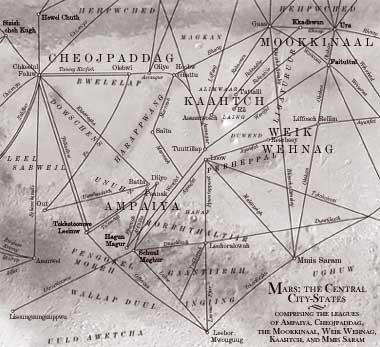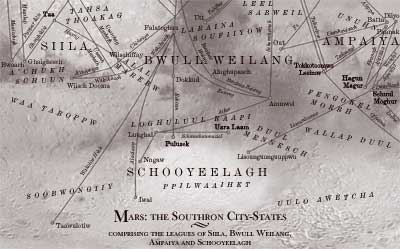God, hes left as on aur oun.
Mars
or, Mappa Mundi (the vague direction thereof).
- There are striking differences between “Canal” Martians and “High” Martians. Putting it bluntly (which, you should remember, almost always is misleading), Canal Martians are much more like Earthlings than High Martians, who are rather, well, not. Some might call them two different species; it remains to be seen how true this is. There is some intermarriage, but it’s almost entirely of a ceremonial nature, and almost never results in offspring; when it does, said offspring are always venerated as near gods or hated and despised as demons incarnate. Or so the stories go, anyway. There aren’t all that many around these days for anyone to go and do some objective verification. Perhaps because intermarriage is almost unknown, these days. Population pressures have fallen off to the point that they just aren’t as necessary as they used to be, to secure alliances and formalize territorial claims. Perhaps.
- Then again, that could just be horseshit (or the nearest Martian equivalent), and those ghettoes of pie-bald untouchables by the abandoned canal sump are the result of what happens when High Martians rape and pillage a Canal Martian caravan or suburb or bazaar and then the kids are turned loose to fend for themselves. Who knows?
- Of course, it isn’t “Mars.” Or “Martian.” Or “Ares.” Depending on who you ask, it’s Melender, or Gheltok, or Lipirh, or Laskar. The first two are terribly old, and though they pop up all over the planet, one can trace them to High Martian languages if one is patient enough. “Lipirh” and “Laskar” are more recent coinages (as old as Babylon, say); found more commonly among the Canal Martians, especially where tensions between the new school monotheists and the old school pantheists are high. (Lipirh being the Widowed Mother, name of choice among the pantheists; Laskar, the Blood of God, and we know who likes to go for that kind of crap.) But most Canal Martians—to whom actively asserting a religion is either intellectually gauche or not really something they think about, from day to day—just call the planet Melender, or some derivation of same, more often than not; it’s the closest equivalent of “Earth” here on, well, Earth. (Erde. Myr. Terra. Etc.)
- Which begs the question: what do they call Earth?
- High Martians—those I’ve bothered to think about—speak a language rather remarkably like Cornish, or so a linguist might well note. Thus, I will call them by their “proper” name: the Gaurgathi. There are, of course, as many names for Gaurgathi as there are languages among them, and as many nasty little nicknames as there are nasty little imaginations to dream them up. (Koska and Plati leap to mind, for instance.) Similarly, the Canal Martians—at least that branch whose locus happens to be in and around the religious dispute alluded to earlier—speak a language which, remarkably enough, would seem to partake of Carolinian and a smattering of Indonesian; they are referred to (as a race, in these parts) as Gehelender, or Choltoc, or Opais, or Liannan. None of which came from either of the actual languages which I’ve pillaged. So sue me.
- Most Liannan (to pick one; we’re talking about the Canal Martians, here) are sallow: pale yellows, oranges, ochres and reds abound in skin tones. Eyes are typically gold, hazel, yellow; the occasional dark hazel, green, or exceptionally rare brown are named “mud-eyes” and are generally considered to be terribly lucky. Pupils are slit, like a cat’s. Most have a faint down on their skins, and what hair they have tends to grow close and tightly matted, like thick curly hair or short fur. (There’s a qualitative difference between hair and fur, or so I’m told. Damned if I know what it is.) Gaurgathi have low brows (criminal intelligences) and high-set ears and noses that tend towards the big flat squashed variety. They tend to be much more hirsute and actually grow long manes and facial hair (males and females). They tend to be slim (most inhabitants of Melender are ectomorphic) but with enormous, bellows-like chests to better breathe the thin, thin air.
- There are also some “blue” Melender. Mostly among the Gaurgathi, though they occasionally pop up among the Liannan—mostly far, far away. (From where we stand here and now, by this as yet unnamed canal, near this brewing religious conflict.) Their skin is a deep indigo black, the color of the sky at zenith; they are known as Bhel, Dulas, Sienni, Bwong’iit, and they tend to keep to themselves.
Elysium and the surrounding environs.
The inhabitants of the city-state of Ammwel follow a bizarre cult-like set of strictures: the Ocqotong. They must keep detailed journals of their daily transactions, and diaries of their innermost thoughts; these writings are gathered together, encoded and read through some sort of double-blind system (so that no one currently living can be identified with their writings—well, not easily), annotated, collated, cross-referenced, and shelved among the collective memory of the entire city for the past couple of millennia in the great Perpus Takaan, a magnificent example of Later Hy’attit design. These are used to examine recurring patterns in history and to correlate and attempt to identify reincarnations of previous Ammweli; once someone dies, their writings are released to whatever priestly hierarchy runs the Takaan (the Ppappalepal, perhaps, who are dour, and wear silly codpieces), and an attempt is made to fix their past identity, their place in yon Great Scheme of Things. (Since ancestor worship is a big deal, having a relative who just died turn out to have been the reincarnation of someone important from eleven hundred years ago—based on the similar style with which they composed their grocery lists—well. This can be quite prestigious, if not lucrative.)
The Hellas Basin.
The Ampaiya League— Comprising the city-states of Tokkotoomwo Leeimw, Out, Batta, Diiyo, Paanak, Hagun Magur, Schuul Moghur, Leehoralowah and Leehor Mwouguug, the Ampaiya League is one of the richest and most cosmopolitan on Mars, vying with the Schoorhugullang in industry and agricultural output. Its network of canals is also arguably the best maintained, counting among its number the Offriina, the Liibw, the Uumhaidasch, the Werefat and Ayuufat, the Ffranogh and Afittikka, and the mighty Talimaat corridor. Ampaiya is a major source of liftwood, and, through trading along the Werefat and Ayuufat canals, is one of the only outlets for the narcotic attigha, grown in the cool, dry foothills of the Kaahtch. Though Lisounguunguuppwu is these days considered more a member of the Schooyeelagh, thanks to the Duul Mennesch caravan trade, close ties are nonetheless maintained with Ampaiya, and the water pumped from the Ppilwaaihet along the Lisounloomw canal is another important factor in Ampaiya’s vitality.

The planet Mars, with major canal systems indicated.

















The Red Planet; the Apple IIc
Two meditations on Mars from the wonderfully redesigned long story; short pier. William Gibson owes it all to Apple (link...
kip manley on mars
Long Story, Short Pier, Red Planet....
I am unspeakably jealous.
Sir:
I am unspeakably jealous.
Good Day to you.
Stefan
Sir,
A most impressive analysis. May I ask about your source material? Did you create this whole-cloth, or do the subject races and cultures appear somewhere else?
I would very much like to acquire a copy of the source of this idea, if you did draw it from elsewhere. I have a use for such a complex culture based on a Victorian-era Mars.
Thank you,
Thomas S. Higgins
First things first: like anything else on the website, the materials in the Mars posts is covered under a Creative Commons license. It’s a basic non-commercial, share-alike license: you’re free to copy, distribute, or make derivative works from it, so long as you don’t do so for commercial reasons, and do so under similar terms. So copy away! (Just don’t link directly to the maps. Bandwidth, you know.)
As for sources: first, as I’m sure everyone has guessed, the basic background was inspired largely by Space: 1889. (Hence the liftwood.) As for the rest: grab Borges and Lovecraft and everything in between, then season liberally with various Forgotten Futures and a dash of the Petal Throne. —The maps: the terrain comes from various photomosaics compiled by NASA (your tax dollars at work!), supplemented with false-color maps to puzzle out the basic areology, then tweaked in Photoshop to make a nice Victorian duotone. I overlaid a couple of Schiaparelli’s hand-drawn maps of canale, stretching and twisting and distorting them just enough to fit the landscape—always keeping in mind that the Martians were superhuman engineers; some of those canals are slender aqueducts on skyscraper-high pylons. Drop cities where you’d expect cities to be, and voila! Instant map of Mars, ca. 1891. (I still haven’t gotten around to marking the latitude and longitude. Ah, well.)
As for the place names: I did what I usually do, which is check out dictionaries for obscure languages from the library. For Mars, I mostly leaned on Carolinian (a member of the Trukic subgroup of the Micronesian group of Oceanic languages), with some Papago (a member of the Utoaztecan language family [once] spoken throughout the central and western United States and northern Mexico) and Cornish (one of the ‘p’ Celtic languages, along with Welsh and Breton) and some stuff gleaned from a random Indonesian phrase book thrown in for good measure. —With dictionaries, I can throw out word-shapes and -textures I wouldn’t ordinarily have come up with (look! exoticism!), while remaining obscurely secure that they sound like a reasonably consistent language. Because, you know, they mostly are. (To the extent anything is.) Also, I can plug obscure in-jokes and coded references into place-names and common words.
Anyway: while, again, you’re more than welcome to use these notes and maps as you see fit (within the bounds of the CC license), the basic process of making the maps is pretty simple, for anyone with an internet connection, a decent image-manipulating program, and lots of finicky patience. I’m tickled at the idea that there might be some other stories set (say) in the city-states of the Schooyéélágh, or the Gathered Clans, but stop and think: vague Polynesianisms might not fit your own idea of what Mars tastes like. Maybe one of the neo-Aramaics, for a desert-y feel? Or something in Arawakan, a bit further afield? Maybe the golden Canal Martians of the Heketi Naca’n paddle their slender-hulled piraga’ up the long, straight, placid ama’ toward the Naca, the last dead sea on Mars. —Instead of the Schooyéélágh, with their flat-bottomed pobwóór, and their long, straight, placid loomw that carry the last sluggish water from long-dead Ppilwaaihet.
That's delightful. I love this sort of stuff. What about a block of Martian stamps a la Donald Evans?
Those are so cool! Thanks, Paul (and Blowhards). Definite Deltiolography material.